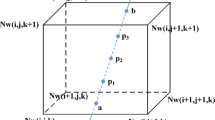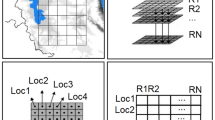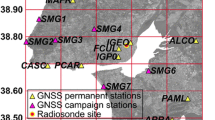Abstract
GNSS tomography is a method for the three-dimensional reconstruction of wet refractivity (\(N_{w}\)) in a set of voxels, each covering a specific part of the troposphere. The substantial assumption is the homogeneity of atmosphere in each voxel in given time intervals, known as the time response of model. Determining the optimal time resolution is one of the existing challenges in the tomography of the Earth’s atmosphere. We apply Empirical Orthogonal Functions (EOFs) to find an optimal time response for our tomographic model. To investigate our method, we compute the EOFs using the numerical atmospheric model that is available in our test area as the reference field on an already designed tomographic model. Using time resolutions of 30, 45, 60, 75, 90, 105 and 120 min, our EOF based method suggests the time periods of 60 to 75 and 75 to 90 min as the time response in the two days (a dry and a wet day) of our experiments, respectively According to our analysis, because of the quality of our reference field, it is not possible to expect similarities better than 85% for wet day and 93% for dry days in the scattering of the \(N_{w}\) field between the reconstructed images and our reference model.





Similar content being viewed by others
Data availability
All the datasets used in this study can be obtained from the corresponding author.
References
Adavi Z, Mashhadi-Hossainali M (2014) 4D tomographic reconstruction of the tropospheric wet refractivity using the concept of virtual reference station, case study: northwest of Iran. Meteorol Atmos Phys 126(3):193–205
Adavi Z, Weber R, Rohm W (2022) Pre-analysis of GNSS tomography solution using the concept of spread of model resolution matrix. J Geodesy 96(4):1–12
Adeyemi B, Joerg S (2012) Analysis of water vapor over Nigeria using radiosonde and satellite data. J Appl Meteorol Climatol 51(10):1855–1866
Aster RC, Borchers B, Thurber CH (2018) Parameter estimation and inverse problems. Elsevier
Bender M, Dick G, Ge M, Deng Z, Wickert J, Kahle H-G, Raabe A, Tetzlaff G (2011) Development of a GNSS water vapour tomography system using algebraic reconstruction techniques. Adv Space Res 47(10):1704–1720
Bender M, Dick G, Heise S, Zus F, Deng Z, Shangguan M, Ramatschi M, Wickert J (2013) GNSS water vapor tomography. In Deutsches Geo Forschungs Zentrum. GFZ
Bender M, Dick G, Wickert J, Ramatschi M, Ge M, Gendt G, Rothacher M, Raabe A, Tetzlaff G (2009) Estimates of the information provided by GPS slant data observed in Germany regarding tomographic applications. J Geophys Res Atmos 114(D6)
Bevis M, Businger S, Herring TA, Rocken C, Anthes RA, Ware RH (1992) GPS meteorology: Remote sensing of atmospheric water vapour using the global positioning system. J Geophys Res Atmos 97(D14):15787–15801
Caldas-Alvarez A, Khodayar S, Knippertz P (2021) The impact of GPS and high-resolution radiosonde nudging on the simulation of heavy precipitation during HyMeX IOP6. Weather and Climate Dynamics 2(3):561–580
Dem̌sar U, Harris P, Brunsdon C, Fotheringham AS, McLoone S (2013) Principal component analysis on spatial data: an overview. Ann Assoc Am Geogr 103(1):106–128
Dong Z, Jin S (2018) 3-D water vapor tomography in Wuhan from GPS, BDS and GLONASS observations. Remote Sens 10(1):62
Elfving T, Nikazad T, Hansen PC (2010) Semi-convergence and relaxation parameters for a class of SIRT algorithms. Electron Trans Numer Anal 37(274):321–336
Flores A, Ruffini G, Rius A (2000) 4D tropospheric tomography using GPS slant wet delays. In Annales Geophysicae, 18:223–234. Springer
Fodor IK (2002) A survey of dimension reduction techniques. (No. UCRL-ID-148494). Lawrence Livermore National Lab., CA (US)
Guerova G (2003) Application of GPS derived water vapour for numerical weather prediction in Switzerland. Doctoral dissertation University of Bern
Haji-Aghajany S, Amerian Y, Verhagen S, Rohm W, Ma H (2020a) An optimal troposphere tomography technique using the WRF model outputs and topography of the area. Remote Sens 12(9):1442. https://doi.org/10.3390/rs12091442
Haji-Aghajany S, Amerian Y, Verhagen S (2020b) B-spline function-based approach for GPS tropospheric tomography. GPS Solutions 24(3):1–12
Heublein M, Alshawaf F, Erdnüß B, Zhu XX, Hinz S (2019) Compressive sensing reconstruction of 3D wet refractivity based on GNSS and InSAR observations. J Geod 93:197–217
Hirahara K (2000) Local GPS tropospheric tomography. Earth Planet Sp 52(11):935–939. https://doi.org/10.1007/s00190-018-1152-0
Kleijer F (2004) Troposphere modeling and filtering for precise GPS leveling, Delft Univ. of Technol., Delft, Netherlands
Krzanowski W (1979) Between-groups comparison of principal components. J Am Stat Assoc 74(367):703–707
Lee LC, Liong C-Y, Jemain AA (2017) Q-mode versus r-mode principal component analysis for linear discriminant analysis (LDA). In AIP Conference Proceedings, volume 1842, page 030024. AIP Publishing LLC
Natali MP, Meza A (2017) PCA and vTEC climatology at midnight over mid-latitude regions. Earth Planets Space 69(1):1–22
Rohm W, Bosy J (2009) Local tomography troposphere model over mountains area. Atmos Res 93(4):777–783
Rohm W, Bosy J (2011) The verification of GNSS tropospheric tomography model in a mountainous area. Adv Space Res 47:1721–1730. https://doi.org/10.1016/j.asr.2010.04.017
Sadeghi E, Mashhadi Hossainali M, Safari A (2022) Development of a hybrid tomography model based on principal component analysis of the atmospheric dynamics and GPS tracking data. GPS Solutions 26(3):1–13
Trzcina E, Rohm W (2019) Estimation of 3D wet refractivity by tomography, combining GNSS and NWP data: first results from assimilation of wet refractivity into NWP. Q J R Meteorol Soc 145:1034–1051. https://doi.org/10.1002/qj.3475
Wang X, Dessler AE (2020) The response of stratospheric water vapor to climate change driven by different forcing agents. Atmos Chem Phys 20(21):13267–13282
Yao Y, Zhao Q (2016) Maximally using GPS observation for water vapor tomography. IEEE Trans Geosci Remote Sens 54(12):7185–7196
Acknowledgements
We are grateful of National Cartographic Center (NCC) of Iran, for providing the observation files of the northwest part of the Iranian Permanent GPS Network (IPGN). We particularly appreciate Iran meteorological organization for access to radiosonde profiles with dense pressure levels at the evaluated station in this research. We are grateful to Mrs. Mohamadi, researcher in Atmospheric Science and Meteorological Research center of Iran for providing the NetCDF files extracted from the WRF model.
Author information
Authors and Affiliations
Contributions
ES and MMH designed the research and wrote the main manuscript text. AS provided the observation files of the northwest part of the Iranian Permanent GPS Network (IPGN). ES did formal analysis and investigations. ES and MMH interpreted the output results. MMH investigated and approved the results. All authors reviewed and approved the final version of manuscript.
Corresponding author
Ethics declarations
Competing interests
The authors declare no competing interests.
Conflict of interest
The authors declare that they have no conflicts of interest.
Additional information
Communicated by: H. Babaie
Publisher's Note
Springer Nature remains neutral with regard to jurisdictional claims in published maps and institutional affiliations.
Rights and permissions
Springer Nature or its licensor (e.g. a society or other partner) holds exclusive rights to this article under a publishing agreement with the author(s) or other rightsholder(s); author self-archiving of the accepted manuscript version of this article is solely governed by the terms of such publishing agreement and applicable law.
About this article
Cite this article
Sadeghi, E., Hossainali, M.M. & Safari, A. Determining the time response in GNSS tomographic modeling of troposphere. Earth Sci Inform 16, 1867–1877 (2023). https://doi.org/10.1007/s12145-023-00974-0
Received:
Accepted:
Published:
Issue Date:
DOI: https://doi.org/10.1007/s12145-023-00974-0




